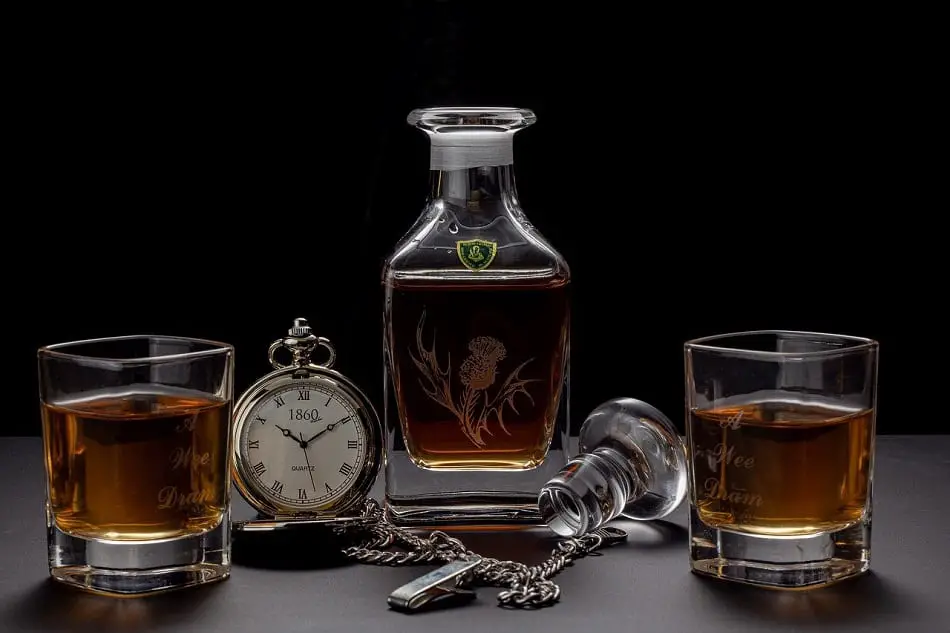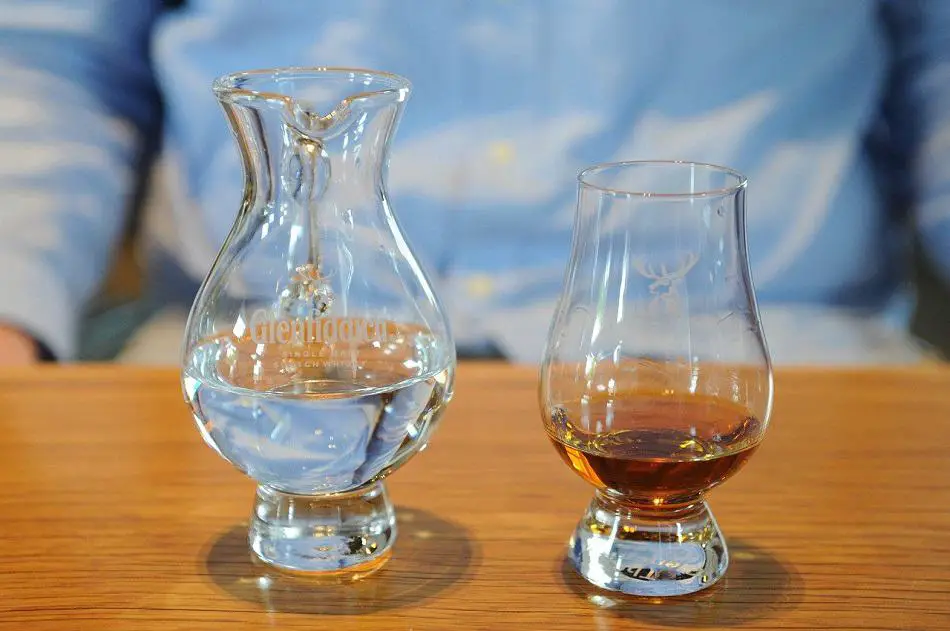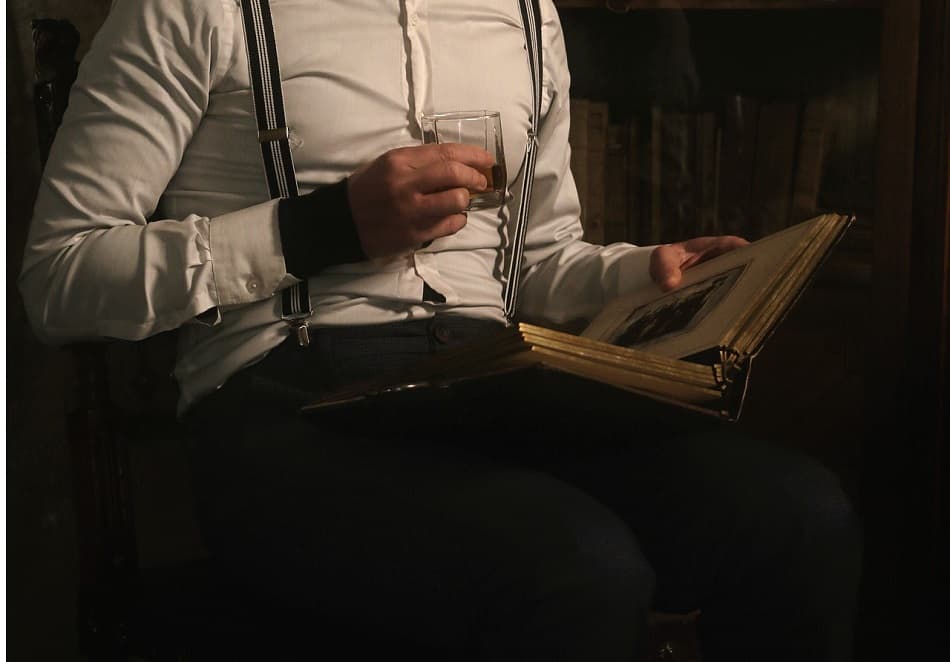Many people think that it takes years of repeatedly drinking whiskey before you can get used to its harsh and unpleasant taste and start to enjoy it, but in fact when it comes to how long it takes to like whiskey, the exact opposite is true.
It doesn’t take any time to like whiskey. You can enjoy your next glass of whiskey as long as do the following three things:
- Reduce the impact of the alcohol
- Find a whiskey with flavors you like
- Spend time trying to detect its aromas and flavors
This doesn’t mean that you’ll instantly appreciate all the subtle nuances of whiskey, but you will start to enjoy whiskey more or less immediately if you do the above three things, the details of which will be explained in the rest of this article.

1. Reduce the Impact of the Alcohol
Whiskey has a very high alcohol level, anywhere from 40%ABV – 68%ABV, which is so strong that the smell and taste of the alcohol overpowers the smell and taste of the whiskey itself. Also, if you smell and taste strong alcohol it can numb your nose and palate which makes it even more difficult to smell and taste the whiskey.
Now the smell and taste of alcohol is not pleasant, and it can take a long time to acclimatize to it, so it’s no wonder that many people think whiskey smells and tastes terrible and that it can take years to learn to like it. It’s because they’re only smelling and tasting the alcohol!
Once you reduce the impact of the alcohol, it’ll be much easier for you to detect the aromas and flavors of your whiskey, and as long as you like them (see next point), there’s no reason you shouldn’t enjoy your whiskey immediately.
Reducing the impact of the alcohol doesn’t take long either. Here’s how to do it.
Use a Proper Whiskey Glass
Whiskey glasses are designed to reduce the impact of the alcohol and maximize your enjoyment of the whiskey’s aromas and flavors. Proper whiskey glasses or nosing glasses are tall with a wide bowl, a long narrow neck, a thin stem and a broad pedestal.
Since you only pour a little whiskey into the glass, air can get to it allowing the whiskey to breathe. This lets the alcohol evaporate while the whiskey aromas concentrate in the narrow rim. Now you’ll smell less of the alcohol and more of the whiskey’s aromas. Once you can smell a whiskey properly it becomes easier to taste its flavors because smell is a big part of flavor.
On the other hand, using say a shot glass, will do exactly the opposite. Being filled to the brim and with no air getting to the whiskey the alcohol won’t evaporate. With no narrow neck in the glass for the whiskey aromas to accumulate either, they will dissipate. That’s why when using a shot glass, there are no whiskey aromas but when you take a sip, you get a face full of alcohol fumes.
So if you’ve only been using a shot glass to learn to like whiskey, it will take you years and even then, you’ll only become acclimatized to the alcohol. All you need to do is simply switch to a whiskey glass and you’ll see a rapid reduction in the impact of the alcohol which in turn, will allow you to actually detect the whiskey and enjoy it immediately.
One of the most popular whiskey glasses is the Glencairn Whisky Glass which you can find on Amazon here .
.
Dilute Whiskey with Water or Chill It With Ice

Diluting your whiskey to 35% ABV by adding water, will obviously reduce the impact of the alcohol.
Chilling your whiskey with ice cubes does the same. As the temperature is lowered the intensity of the whiskey is diminished and the burn of the alcohol is reduced having less impact.
Both of these options will reduce the impact of the alcohol fairly quickly (the water instantly and the ice cubes when they’ve lowered the temperature of the whiskey) and again, that will make it easier for you to pick up the aromas and flavors of your whiskey and enjoy them immediately.
Acclimatize Yourself to the Alcohol
Even with the right glass and some dilution or chilling, it’s quite possible that you’ll find whiskey is still too alcoholic for you and you’ll need to acclimatize yourself to the alcohol each time you drink a glass of whiskey.
This acclimatization is not years of drinking something until you’re used to its unpleasant taste but two quick and easy actions that allow yourself to become desensitized to the alcohol when you first encounter it on your nose and palate.
The first is nosing (or in non-whiskey-drinking language smelling) your whiskey gently so that your nostrils don’t get singed by the alcohol and they can get used to its strength. The second is taking a pre-tasting small sip of whiskey so that your mouth can get used to the alcohol too. The first nose and sip may smell and taste overwhelmingly of alcohol but with the second, you’ll get more of the whiskey’s smells and flavors.
Once again this means you should be enjoying your whiskey within a few minutes of pouring it and not after years of repeatedly drinking something you find unpleasant.
2. Find a Whiskey with Flavors You Like
Many people don’t know this but not all whiskeys taste the same. That awful tasting whiskey your uncle gave you when you were a kid was something he may have liked but that’s no reason to spend years trying to enjoy it when you could go out and buy a bottle of whiskey with flavors you like, today.
Whiskeys can vary widely in their flavors, the number of flavors and in their intensity. Some whiskeys will have lots of flavors while others will have only one or two. Some whiskeys will have flavors that are more delicate and mild while others will have flavors that are more intense and rich. There are sweet whiskeys, spicy whiskeys, fruity whiskeys, floral whiskeys and smoky whiskeys.
As for the flavors, some common ones are: honeysuckle, almond, grass, leather, cream, ginger, toffee, toast, cinnamon, heather, dried fruit, apple, honey, nutmeg, vanilla, nuts, oil, seaweed.
With such a variety you’ll easily be able to find a whiskey or 20 that you’ll like immediately. You just have to make sure, when deciding on a whiskey that you like the flavors it has. You could even search for a whiskey with certain flavors that you really like. As long as you reduce the impact of the alcohol and can taste the flavors of the whiskey that you know you like, there’s no reason why it should take any time at all to like whiskey.

Of course, for the same reason, you’re also going to find plenty of whiskeys with flavors you don’t like, but that’s ok. You know how you don’t spend your life trying to like foods and other drinks whose flavors you find unpleasant, well the same thing applies here. You don’t have to force yourself to like all whiskeys just because you like so many of them.
A General Guideline to Whiskeys and Their Flavors
While all whiskeys are different there are certain generalities that can be used as a rough guide, when determining what flavors to expect from a whiskey.
The grain a whiskey is made from will affect it taste:
- Whiskey made from malted barley will be sweet with lots of caramel, toffee and brown sugar notes.
- Whiskey made from corn will have a sweet syrupy taste, with flavors of white sugar, cotton candy, vanilla and maple syrup.
- Whiskey made from rye will be more spicy, with pepper and cinnamon flavors.
- Whiskey made from wheat will taste of wheat bread and honey.
In general, American whiskeys have the sweetest taste. Bourbon is the sweetest whiskey due to being made from corn which is the most sugary grain used in whiskey production, and so it’s the easiest whiskey to enjoy. Tennessee whiskey which tastes like bourbon is sweeter according to some.
American rye whiskey is spicier and less smooth.
Irish Whiskeys can be quite bourbon-like though they’re definitely not as sweet. They’re lighter and fruitier than Scotch whiskies, and because they’re triple distilled and usually made without peat, much smoother too.
Scotch whiskies can be the hardest to like but with five Scotch Whisky regions producing wildly varying whiskies, some are easier to like than others.
Whiskies from the Highland and Speyside regions produce lighter, sweeter and fruitier Scotches, while whiskies from the region of Islay are the most pungent, peaty and smoky Scotches.
3. Spend Time Trying to Detect the Aromas and Flavors
You can reduce the impact of the alcohol and find a whiskey with all your favorite flavors but if you simply swallow a shot quickly and in one gulp without taking the time to detect the aromas and flavors you still won’t be tasting much of anything.
Trying to detect all the aromas and flavors can take a little time and of course when you first try, it could take a bit longer than that, but it’s still not years of trying to acclimatize yourself to unpleasant flavors. It’s anywhere from 5 – 10 minutes per sip depending on the quality of your whiskey and your aromas-and-flavors-detecting ability. To read more about why it takes so long and how I calculated these numbers, see this article here where I explain it in more depth.

To detect the aromas put your nose into the glass and breathe in deeply but gently – as mentioned you don’t want your nostrils to be singed by the alcohol. Open your mouth slightly as you inhale to let the alcohol fumes escape and the whiskey aromas to circulate round so you can better discern them.
Sniff using one nostril then the other. Generally, one nostril is responsible for 80% of an inhalation while the other is obstructed. You won’t know which one is which because it alternates every two to three hours. So each nostril will perceive the aromas differently.
Vary your rate of inhalation because some aromas are easier to detect when the flow of air is rapid while others are easier to detect when the flow of air is slower.
Examine every part of the glass because different aromas concentrate at different points. At the bottom you’ll find the heavier compounds with earthy, smoky, woody, aromas and higher up you’ll detect the spicy, malty and winey aromas. Towards the rim will be the lighter, fruity and floral aromas.
To detect the flavors, you need to chew your drink. This means holding it in your mouth and swirling it around. Make sure the whiskey spreads throughout your mouth and covers all the surfaces of your tongue – the middle, the sides, the tip and the back – because different parts of your tongue respond to different flavors.
Examine the flavors and then swallow. Take a deep breath, exhaling deeply through your nose so that the aromatic molecules in your mouth go to the back of your throat and rise up into your sinuses. Do not take another sip yet. Wait a moment so that the taste can come back up and you can explore it.
This may seem a lot at first, but when you think about it, it’s simply taking a few minutes to smell and taste your whiskey. And if you do that with a whiskey that has flavors you like and where the impact of the alcohol has been reduced, then it won’t take you any time to like your whiskey.

